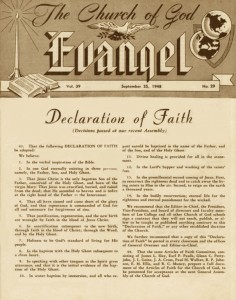Establishing Our Declaration of Faith
By the time General Assembly delegates had made their way out of the Municipal Auditorium in Birmingham, Alabama, in 1948, they had adopted a Declaration of Faith that has unified the Church of God for 66 years.
The Church of God will celebrate this important document by declaring and celebrating January 4, 2015, as “Declaration of Faith Sunday.”
By David G. Roebuck
The fact that the Church of God did not have a statement such as the Declaration of Faith until 1948 does not mean that there was little concern for biblical doctrine. Rather the absence of such a statement reflected our early anti-creedal heritage.
When the Church of God began as the Christian Union in 1886, founder R. G. Spurling passionately opposed creeds of any kind. Like many others in his day, he believed that the adoption of a creed at the Council of Nicaea in 325 A.D. had led to apostasy in the Christian church. According to Spurling’s understanding, all creeds are human interpretations of the Scriptures and can never be considered infallible. As human interpretations, creeds should not be used to divide Christians from one another. Rather, Christians full of the love of God should work together to find the true understanding of Scripture and should continue to fellowship in love despite their differences. According to Spurling, the New Testament holds all that is necessary to know and serve Christ. Spirit-led individuals in Christian community can be trusted to interpret and understand biblical truth.
In this context, our earliest Church of God covenant emphasized the New Testament as our “only rule of faith and practice” and guided the theological life of our movement. Occasionally, needs for further statements have arisen, however. In 1910, the General Assembly appointed a committee to prepare examination questions and biblical references for ministerial candidates. The committee’s report noted that the church stood for “the whole Bible rightly divided” with the New Testament as our only rule for government and discipline. This committee listed “some of the teaching that is made prominent.” Their list of twenty-five items included basic statements and scriptural references. Some of these statements focused on doctrine such as “Repentance: Mark 1:15, Luke 13:3, Acts 3:19.” Others highlighted Christian practices such as “Total abstinence from all liquor or strong drinks: Prov. 20:1, Prov. 23:29-32, Isa. 28:7, 1 Cor. 5:11, 1 Cor. 6:10, Gal. 5:21.”
The 1911 General Assembly discussed these statements at length and recommended that the “teachings” be reprinted with minor changes. These teachings have remained an important statement of doctrine and practice for the Church of God with occasional amendments as weighty issues emerged in the life of the denomination. In 1988, the Assembly highlighted the importance of Christian practices by adopting affirmations regarding spiritual example, moral purity, personal integrity, family responsibility, behavioral temperance, modest appearance, and social obligation.
The historic anti-creedal approach of the Church of God has allowed for some diversity on theological matters. One of these areas of diversity is the doctrine of sanctification. Early leaders of the movement were Wesleyan-Holiness in belief and practice and taught a subsequent work of grace that cleanses from the roots of sin. Yet, these leaders preached about a holy lifestyle more than they formulated definitions of their theology.
In the 1940s, strong differences emerged about the doctrine of sanctification. Charles W. Conn characterized the ensuing discussion as “centered not so much on the reality of sanctification as on the time and process of its inception in the human heart. Some held vigorously that it is an instantaneous or ‘definite’ work of grace, and others believed it to be continual and progressive.” It was in the midst of this conversation that the Church of God recognized the need for our Declaration of Faith.
When the General Council of Bishops convened in Birmingham in 1948, two days had been set aside to discuss the “matter of sanctification.” But upon the recommendation of Paul H. Walker, the Council agreed that two days were not needed. E. M. Ellis then made a motion that a committee be appointed to draw up articles of faith, paying special attention to an earlier statement approved by the Bible Training School and College Board of Directors.
The appointed committee included proponents of both views of sanctification. James L. Slay, a respected minister and scholar, chaired the committee. Three days later, the committee brought back our present fourteen-item Declaration of Faith, which both the General Council and the General Assembly approved. Although the statement has never been seen as reflecting all that the Church of God believes, it has remained our foundational statement of faith for 66 years.
DECLARATION OF FAITH
We believe:
1. In the verbal inspiration of the Bible.
2. In one God eternally existing in three persons; namely, the Father, Son, and Holy Ghost.
3. That Jesus Christ is the only begotten Son of the Father, conceived of the Holy Ghost, and born of the Virgin Mary. That Jesus was crucified, buried, and raised from the dead. That He ascended to heaven and is today at the right hand of the Father as the Intercessor.
4. That all have sinned and come short of the glory of God and that repentance is commanded of God for all and necessary for forgiveness of sins.
5. That justification, regeneration, and the new birth are wrought by faith in the blood of Jesus Christ.
6. In sanctification subsequent to the new birth, through faith in the blood of Christ; through the Word, and by the Holy Ghost.
7. Holiness to be God’s standard of living for His people.
8. In the baptism of the Holy Ghost subsequent to a clean heart.
9. In speaking with other tongues as the Spirit gives utterance and that it is the initial evidence of the baptism in the Holy Ghost.
10. In water baptism by immersion, and all who repent should be baptized in the name of the Father, and of the Son, and of the Holy Ghost.
11. Divine healing is provided for all in the atonement.
12. In the Lord’s Supper and washing of the saints’ feet.
13. In the premillennial second coming of Jesus. First, to resurrect the righteous dead and to catch away the living saints to Him in the air. Second, to reign on the earth a thousand years.
14. In the bodily resurrection; eternal life for the righteous, and eternal punishment for the wicked.
(Dr. David Roebuck is director of the Dixon Pentecostal Research Center in Cleveland, Tennessee)





